 When it comes to lost cartoons we tend to look at the silent era – where over 50% of all animation produced are gone due to neglect, oversight or nitrate deterioration. The sound era (since 1930) have a better track record of existing, thanks to the general popularity of cartoons and their immediate value in the after-market (for sale as home movies and concurrent non-theatrical distribution to schools, hospitals, churches and military bases – and later television syndication).
When it comes to lost cartoons we tend to look at the silent era – where over 50% of all animation produced are gone due to neglect, oversight or nitrate deterioration. The sound era (since 1930) have a better track record of existing, thanks to the general popularity of cartoons and their immediate value in the after-market (for sale as home movies and concurrent non-theatrical distribution to schools, hospitals, churches and military bases – and later television syndication).
That there are any lost sound cartoons is a mystery to me. Especially cartoons from major studios, with large libraries that sold to television in the 1950s. Every title was another piece of gold. How could any studio intentionally omit a film from broadcast availability?
We can certainly understand why many 1930s-40s cartoons were later withheld from television showings (wartime shorts and films with drinking, drug use and racial stereotypes in particular). But there were other reasons why historians find holes in certain cartoon filmographies – including the fact that some films actually, somehow, got lost.
Let’s take Terrytoons for example – There must be two dozen from that studio that have never re-materialized since their original release. For this post, I’m concentrating on a particular group produced between 1938 and 1942 that apparently were never included in the CBS TV package. Not part of Barker Bill or The Farmer Alfala Show. The good news is that their negatives do exist (at the UCLA Film and Television Archives). And two or three of these have shown up in 16mm amongst film collectors (with their original titles – indicating that these were part of the non-theatrical track when they were first produced).
 There were some early-talkie Terrytoons that were left out of the original TV package for reasons we can’t yet determine – and several color shorts during the war years that were removed due to vicious wartime stereotypes – all of them equally rare. Of the eleven we focus on in this post, ten seem to have been intentionally omitted for broadcast purposes for essentially the same reason: they were remade in later years in color; the color version being a virtual remake – and thereby replacing the original entirely.
There were some early-talkie Terrytoons that were left out of the original TV package for reasons we can’t yet determine – and several color shorts during the war years that were removed due to vicious wartime stereotypes – all of them equally rare. Of the eleven we focus on in this post, ten seem to have been intentionally omitted for broadcast purposes for essentially the same reason: they were remade in later years in color; the color version being a virtual remake – and thereby replacing the original entirely.
Remaking earlier black and white Terrytoons was not uncommon for the studio in the late 1940s early 50s. Our Wednesday columnist, Charles Gardner, had previously written about this on this blog:
…a few closely parallel pairs still exist in the vaults. “The Last Indian” (1938) was remade shot for shot (including reuse of the original Dayton Allen soundtrack) as “The Wooden Indian” (1949) – with the exception of an extended sequence in the original using the animated Indian in a car run amuck careening through rear-production footage of a live-action thoroughfare – they couldn’t figure out how to redraw it in color, so they wrote a new ending sequence. “Mrs. Jones Rest Farm” (1949) reuses most of the footage from Farmer Al Falfa’s 1937 “Pink Elephants”. “The Covered Pushcart” (1949) recasts Gandy Goose and Sourpuss in the role of Farmer Al Falfa for a substantial shot-fot-shot refilming of “Trailer Life” (1937). “Mighty Mouse Meets Bad Bill Bunion” (1945) reuses substantial footage and a production number from “The Golden West” (1939). And the second half of “Dear Old Switzerland” (1944) is a digest version of “Swiss Ski Yodelers” (1940). I believe both versions of the film called “The Snow Man” (1940 and 1946) may also share footage (though the internet has everything loused up to compare this one, repeatedly misattributing the 1930’s Ted Eshbaugh film as the 1940 Terrytoon). While Gandy Goose’s “Spring Fever” (1951) uses no actual animation from its predecessor, it is basically a shot for shot modernization of 1938’s “Gandy the Goose”, the character’s premiere.
So here are the missing 11 – the black and white originals discarded after being remade in color. Links to the color remake appear below.
Eliza Rides Again – 1938 (reworked as Eliza On Ice with Mighty Mouse in 1944)
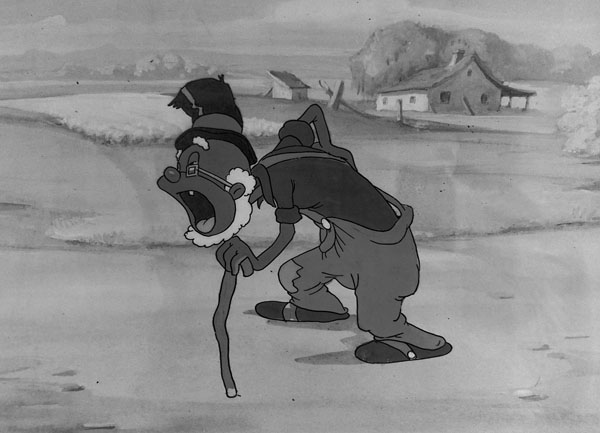
This is actually a scene from “Mississippi Swing” (1942) a Technicolor cartoon also never released to TV – However, I suspect this character – and possibly this animation – also appears in “Eliza Rides Again”.
The Stranger Rides Again – 1938 (remade as The Mysterious Cowboy in 1952)
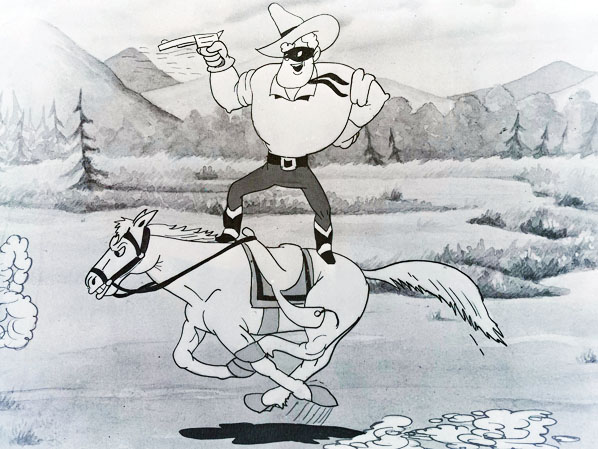
Village Blacksmith – 1938 (remade as Time Gallops On in 1952)
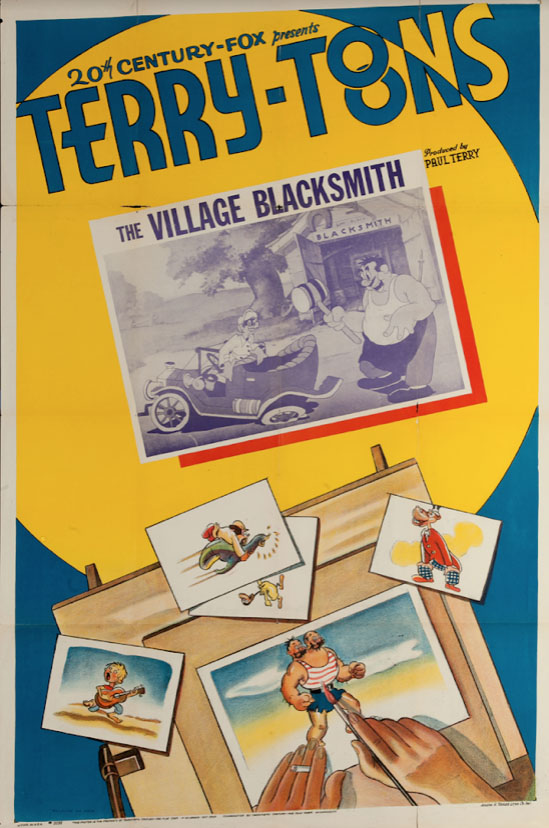
The Old Fire Horse – 1939 (remade as Smokey Joe in 1945)

Professor Offkeyski – 1940 (remade as One Note Tony in 1947)
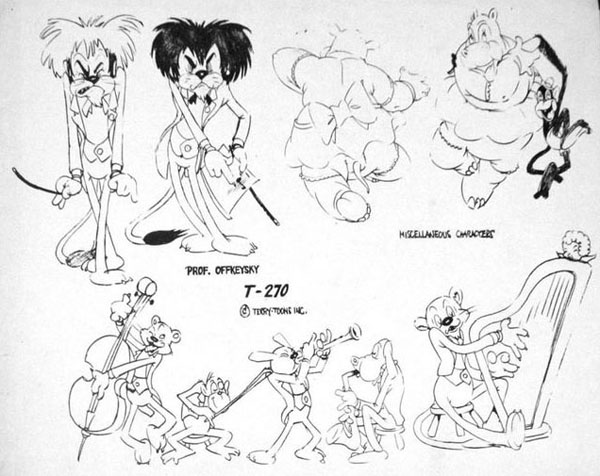
Happy Haunting Grounds – 1940 (remade as Seeing Ghosts in 1948)
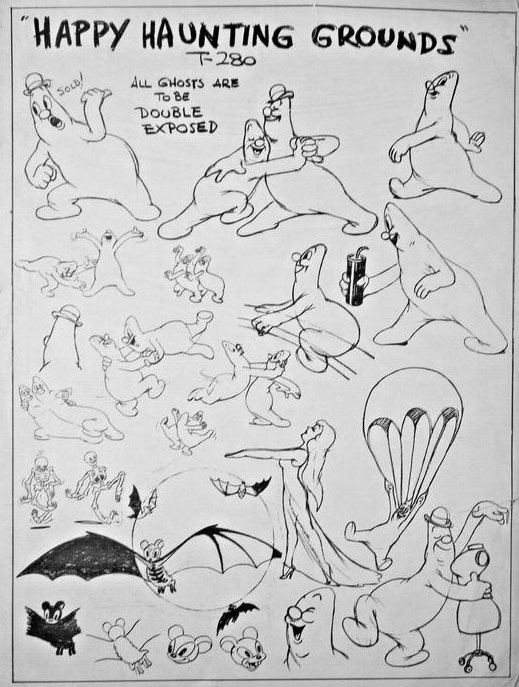
The Baby Seal – 1941 (remade in 1952 as Flipper Frolics)
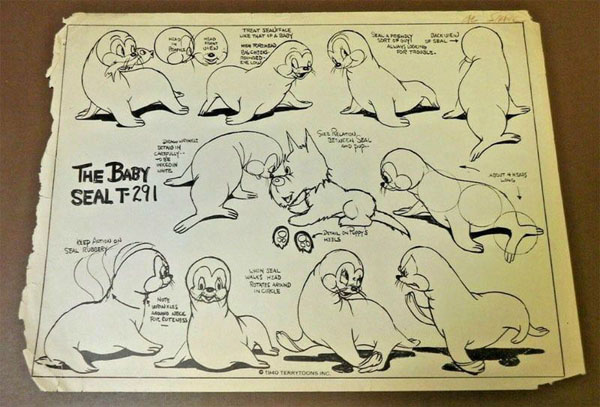
UPDATE (9/24/21): The Baby Seal has shown up as a 16mm Barker Bill print on ebay!
The Magic Shell – 1941 (refilmed in 1952 as Seaside Adventure)
Good Old Irish Tunes (Gandy) – 1941 (remade as Songs Of Erin in 1951)
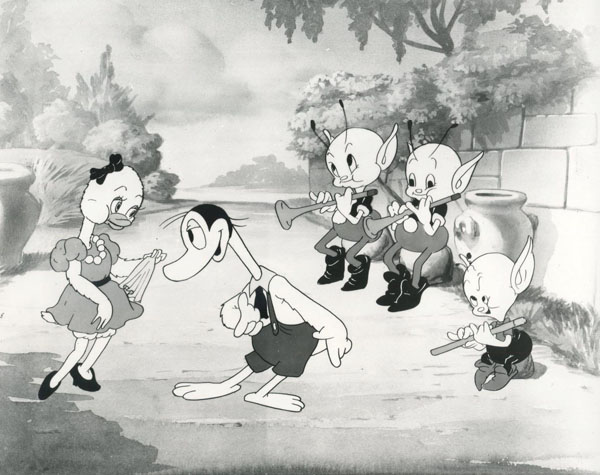
Funny Bunny Business – 1942 (remade as Hounding The Hares in 1948)
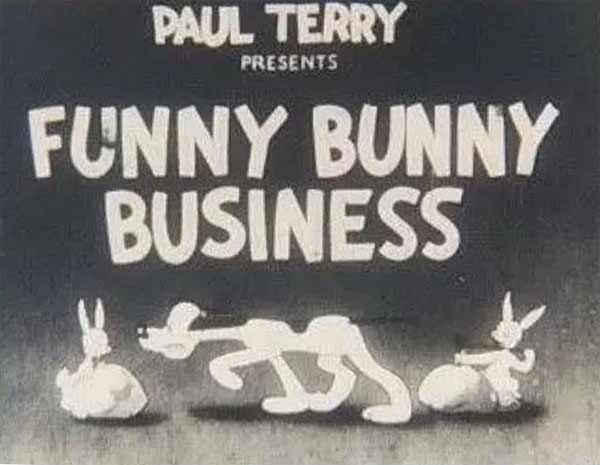
The Outpost – 1942 (this black and white Gandy Goose was not remade per se – but several more cartoons featuring Gandy & Sourpuss versus the Japanese enemy were subsequently produced in Technicolor – and several of those have also been forever banned from reissue)
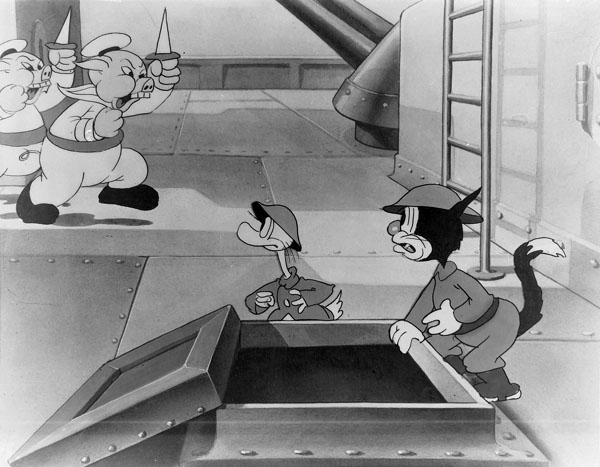
(Special thanks to Charles Gardner, Milton Knight and Strummer Cash Petersen for their invaluable assistance in assembling this post)


 Jerry Beck is a writer, animation producer, college professor and author of more than 15 books on animation history. He is a former studio exec with Nickelodeon Movies and Disney, and has written for The Hollywood Reporter and Variety. He has curated cartoons for DVD and blu-ray compilations and has lent his expertise to dozens of bonus documentaries and audio commentaries on such. Beck is currently on the faculty of Cal Arts in Valencia, UCLA in Westwood and Woodbury University in Burbank – teaching animation history. More about Jerry Beck [
Jerry Beck is a writer, animation producer, college professor and author of more than 15 books on animation history. He is a former studio exec with Nickelodeon Movies and Disney, and has written for The Hollywood Reporter and Variety. He has curated cartoons for DVD and blu-ray compilations and has lent his expertise to dozens of bonus documentaries and audio commentaries on such. Beck is currently on the faculty of Cal Arts in Valencia, UCLA in Westwood and Woodbury University in Burbank – teaching animation history. More about Jerry Beck [



































At first blush it seems odd that Terrytoons would not syndicate the original versions of these cartoons along with their Technicolor remakes. After all, over twenty of the late episodes of “Bewitched” with Dick Sargent were literal remakes of earlier episodes with Dick York, and yet all were included in the syndication package. (When executive producer William Asher was asked about this, he replied: “We didn’t think anyone would notice!”)
However, when the Terrytoons package was sold to CBS, practically all TV sets were black-and-white, and very few stations were capable of broadcasting in colour. Under the circumstances, the remakes would be virtually identical to the originals, and the latter could with some justice be regarded as superfluous.
I notice that in the “Happy Haunting Grounds” model sheet, the sleepwalking ghost’s legs are visible through her diaphanous gown; but in the Technicolor remake “Seeing Ghosts”, her gown is opaque. Might her gown have been translucent in the original cartoon, rendering her “double exposed”? Hopefully further research can tear the veil from this mystery.
One black-and-white Terrytoon that I really wish had been remade in Technicolor is “Club Life in the Stone Age”. As Cave Pop says of his nubile daughter: “What a gal!”
I guess they didn’t even consider doing a colour remake of “Ickle Meets Pickle”….
Excellent Jerry, glad the poster photo I sent you contributed to this interesting post about Paul Terry and his great Terrytoons. Martín
Your personal inquiry about the cartoon for your poster (“The Old Fire Horse”, pictured above) was indeed the catalyst for this post! Thanks Martin!
Thanks for letting me know. I watched on youtube several times, thank you Jerry!
“The Outpost” and “Somewhere in the Pacific” have been on my “most wanted” list for decades.
Happy to of helped! The missing in action Terrytoons are some of the most interesting conversations, considering their out of the package for many a reasons. I suspect they rerecorded the soundtrack for the remakes of the shorts, particularly because in “Songs of Erin”, it’s clear that Arthur Kay isn’t doing the louder Gandy laugh like in the earlier shorts. The “re-inking” of the B&W shorts isn’t the best either. For time it often seems to remove details and comes off a bit crude in some cases.
How come the other remade b/w cartoons are properly archived like the first Gandy goose cartoon later remade in to Spring Fever
Funny Bunny Business and The Outpost? Here in 16mm!
Yay! I would assume they both have their original titles – as they are not in the TV package. I’m hoping the others show up the same way! Any other collectors have the remaining nine?
As the actual owner of THE OUTPOST print that Tommy Stathes is storing for me in his archive—I can state that it’s a French 16mm print with a French title that translates to “Adventures In the Pacific.” (This would seem to invite confusion with another lost Gandy, SOMEWHERE IN THE PACIFIC, but from movie review descriptions of the latter, I’m aware that it’s both a very different story and in color…)
Thanks for the information.
Yow, that Good Old Irish Tunes still!
What’s up with that little elf/gremlin in the foreground? That facial expression is something only Tyer could create.
Was he doing some moonlighting prior to his official stint with Terry?
The small elf is a Rasinski drawing. Animator George Bakes (who was there) said that Rasinski was a big influence on Tyer’s post 40s style. And Rasinski’s style had been inspired by Bill Tytla.
But yet ViacomCBS STILL neglects the library…
The “Snow Man” mixup of the 1940 Terrytoon with the 1933 Eshbaugh short over the web is stunning. Here is the real thing: https://mega.nz/file/OL5miLTR#o1TUAj2Nsa-j1ZzaqHSKKyxIZ3JBcHKnm5DrYKf9ths. If you compare it with the 1946 version (https://www.youtube.com/watch?v=U1B44HhOK7Y), there is some animation reuse but also new animation, and while the snowman is practically copypasta, the rabbit kid characters have been redesigned (not necessarily for this short alone). I would suspect a similar blend of old and new animation for the other color remakes, too.
Coincidentally, I have been browsing through my Garage Sale collection of Terrytoons over the weekend, so this post is a really nice treat for me.
Addendum 20 months later: The 1940 version of “The Snow Man” (with original titles) got uploaded on Youtube recently. Watch it here: https://www.youtube.com/watch?v=EYxKlnSKzHI
This post is quite fascinating, and I guess you can find examples of this at other notable animation studios during the theatrical golden age, like Warner Brothers’ reworking of black and white footage in color with “something new” added. Bits and pieces like that make both versions worthy of exploring. My own naive guess around why records are lacking when it comes to Terrytoons is that the studio’s output has seemingly gone missing on the TV airwaves or in theaters. I don’t have to tell anyone on this page that there aren’t even any thorough collections of these cartoons on physical media. In fact, outside of the set around the more recent MIGHTY MOUSE shorts, I’d go so far as to say that there are *NO* existing TERRYTOONS filmography on disk since the format began, save for collections of 1930’s cartoons that pick the occasional TERRYTOONS title as examples of how the world looked through the animated eye. When people ignore certain aspects of animation history, there are many times that the records go missing. I hope I’m wrong, believe me. thanks for diving deeper in here.
There are also many sound Terrytoons from 1930 to ’35 that never show up, but I’m not going to list them. Too much competition among film collectors for my taste, sharing info just drives up the prices.. I have a black and white print of “The Last Indian” with the combination footage at the end, which is a TV print, so it’s not all that rare. Also, we might consider just about ALL of the sound Terrytoons incomplete, due to the CBS network’s policy of cutting about a minute out of every one on them. Also the 1930s Terrytoons were censored by CBS in spots by just repeating “safe” scenes and sequences over and over again. This practice makes the Terrytoons look even cheaper than they are. The 35mm Viacom elements to these cartoons reside at UCLA, some have been scanned, but can we see them? Huh-uh.
“Seaside Adventure”: Why, if that ain’t the Barker Bill song, played rooty tooty style, that plays at the start of every TV version (and now YouTube). Praise be, now we know where it came from, and of course we’re not sick of it, no sir.
Jerry, I sent you a not-great off-air copy of THE MAGIC SHELL a few years back…it was shown on US TV for sure. But it badly needs an upgrade. Pretty sure it wasn’t the remake.
I have a super 8 copy of the tv print of “The Stranger Rides Again”, entitled “Range Rider”.
This is certainly interesting… I watched a good amount of Terrytoons as a kid so I understand “lost” ones in this context. Especially if any might have been banned, maybe due to racial characterizations? (The apparently Japanese pigs with Gandy and Sourpuss… yes they’re the enemy but the single frame above doesn’t fully tell if the drawings themselves would now be considered offensive, but it seems they could be) — In the past there’ve been many references to banned cartoons with such stereotypes but I don’t believe I’ve ever heard of any Terrytoons included among them!
Otherwise, in another context, it feels like ALL the old Terrytoons could now be considered lost — I could be wrong but it seems like the CBS SatAM “Mighty Mouse” show from 1989 (Bakshi) may be the last hurrah for them? Now that’s over 30 years ago! The older “more familiar” characters Gandy, Sourpuss, Deputy Dawg, Mighty Heroes etc., were momentarily resurrected in that series… unless someone has since re-animated them and I’ve never heard tell of it?
Another color remake is 1949’s ‘Mrs. Jones Rest Farm’, reusing footage from ‘Pink Elephants’, except now starring Looey Lion instead of Farmer Al. Surprisingly, the cut scenes from Elephants ARE included in Rest Farm, giving a peek into what they entailed.
23 months after this post, “The Old Fire Horse” (1939) has emerged: https://www.youtube.com/watch?v=DLFurO2bFSM. Compared with its remake “Smoky Joe” (1945), very much like for other known remakes, some schenes were directly lifted from the black-and-white template while new scenes were added and redesigned. Interestingly enough, the film comes with “Barker Bill Show” titles, so it was probably on TV back in the days.